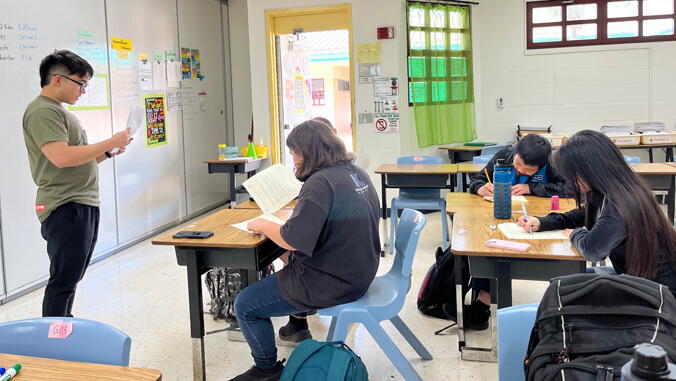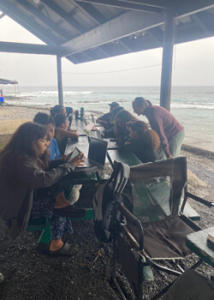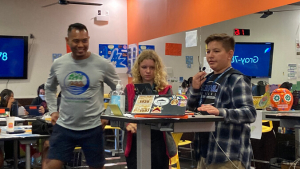
The University of Hawaiʻi at Mānoa Department of Mathematics in the College of Natural Sciences was at the forefront of COVID-19 mathematical modeling for the state throughout the pandemic. Now, its faculty and students are translating the data and knowledge gained into a new curriculum for K–12 students, with a special focus on those underrepresented in the STEM fields.

Led by Professors Monique Chyba and Yuriy Mileyko, the team composed of undergraduate and graduate students, as well as temporary assistant professors has been partnering on Oʻahu with Kapolei Middle School, Voyager Public Charter School, DreamHouse ʻEwa Beach public charter school, and Kua O Ka Lā New Century Public Charter School on Hawaiʻi Island to conduct weekly visits and bring their newly developed curriculum into the classroom.
The curriculum includes a series of worksheets with mathematical questions that have been designed to, for example, compare the 1918 Influenza pandemic with the COVID-19 pandemic through data to draw similarities and differences. The basic reproduction number is also introduced conceptually and used to derive an equation for diseases spreading in a specific setting. The state’s daily cases and hospitalizations from the pandemic are analyzed for the students to get exposed to linear and exponential functions. The focus of one lesson is to analyze data from the Hawaiʻi Department of Health to understand how the disease has disproportionately affected certain ethnic groups compared with others.
“Assisting K–12 students throughout the semester has been an incredibly fulfilling experience, as I witness their growth and potential firsthand,” said UH Mānoa student Ralph Martin Adra. “It is invaluable to translate the data collected during the pandemic into real-life lessons for these young minds, enabling them to understand the world around them and inspire them to navigate the challenges of the future with resilience and determination.”

UH Mānoa student Winnie Lau added, “It was inspiring to watch the students grow, persevere, and make their own connections about how the lessons they learned could be related to their own life. Although numbers may not seem like much at a first glance, they have their own story to tell, and it gives an idea to the students about how there is always more to think about beneath the surface once they start to think deeper.”
DreamHouse ʻEwa Beach launched its high school in fall 2022 with a ninth grade class of 84 students and a vision to implement active, collaborative, inquiry-based learning through a culturally responsive pedagogy—a vision that is aligned with the mission of the initiative.
“When students struggle with mathematical concepts, many times the barrier is when these concepts are not contextualized to their lives,” said Phillippe Fernandez-Brennan, DreamHouse’s ninth-grade math and science teacher. “The math concepts and practices of creating data tables and scatter plots, interpreting data and identifying patterns to creative algebraic equations became much more accessible for my students through the COVID-19 pandemic. This partnership was a highlight for this academic year because this provided a learning experience that I would not have been able to provide my students.”
Hawaiʻi State Math Challenge

The UH Mānoa team and Associate Professor Kamuela Yong from UH West Oʻahu collaborated to host the Hawaiʻi State Math Challenge at DreamHouse ʻEwa Beach in April. More than 100 students were presented with characteristics of a new virus, including mode of transmission, symptoms, morbidity and more. Using data provided by the UH team, the students were asked to provide recommendations regarding travel restrictions, mitigation measures, recommended behavior and vaccination protocol. Kyle Dahlin, a Native Hawaiian PhD in applied mathematics and expert in infectious disease ecology was a guest speaker at the event.
“Observing the K–12 students apply the tools they learned with us on a scenario involving a new virus spreading in the world with characteristics slightly different from COVID-19 was hearthwarming. The students were highly engaged and creative,” Chyba said. “Fostering group discussions and emphasizing teamwork over individual results is key to creating an inclusive environment where all students can excel in mathematics.”
The outreach educational initiative, 808 Math Island Style: Computational Modeling and Simulation of Epidemic Infectious Diseases, was developed by a team of UH faculty and funded by the Mathematical Association of America’s Neff Fund Outreach Program. The Hawaiʻi State Challenge also received funding from the UH SEED Inclusion, Diversity, Equity, Access and Success (IDEAS) as well as from Associate Professor Elizabeth Gross’ CAREER grant.
More details can be found about this project in pages 16–17 of the June–July issue of MAA FOCUS, the newsmagazine of the Mathematical Association of America.

